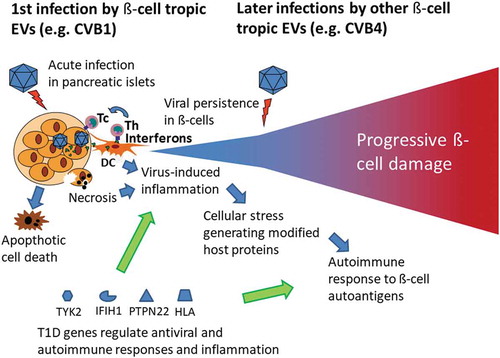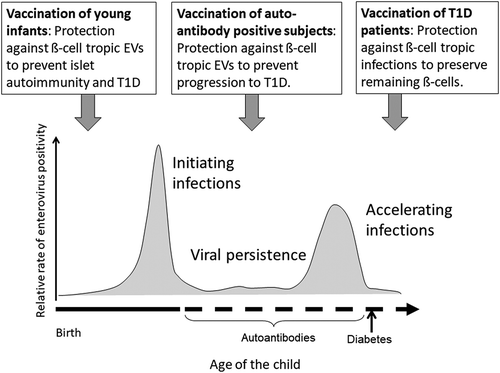Figures & data
Figure 1. Model for enterovirus (EV)-induced β-cell damage leading to type 1 diabetes (T1D). The virus infects insulin-producing β-cells in the pancreas leading to viral persistence, cell death and inflammation in infected islets. Host antiviral response is modulated by polymorphisms in genes regulating the immune response against EVs. These polymorphisms are associated with T1D (e.g. IFIH1, PTPN22, TYK2, HLA). The diabetogenic virus-gene interaction is characterized by an inflammation response and subsequent induction of an autoimmune process.
HLA: human leukocyte antigen; IFIH1: Interferon Induced with Helicase C Domain 1; PTPN22: protein tyrosine phosphatase, non-receptor type 22; TYK2: tyrosine kinase 2.

Figure 2. Summary of the scientific concept of preventing type 1 diabetes (T1D) by enterovirus (EV) vaccines. The figure shows the relative rate of enterovirus infections in different stages of the β-cell damaging process in children who develop T1D and different scenarios for the prevention of these infections by different vaccination regimens. Early infection by a β-cell tropic enterovirus strain has been implicated to play a role in the initiation of the β-cell damaging process. Later infections by other β-cell tropic virus strains may generate cumulative β-cell damage that eventually progress to T1D. The primary aim is to vaccinate children before the age of 6 months to prevent infections which are associated with the initiation of the β-cell damaging process. Polyvalent vaccine given at this point would protect also from later infections. In addition, the vaccine could also be given to autoantibody-positive but still nondiabetic children to prevent infections that could accelerate the progression of the β-cell damaging process. Theoretically, the vaccine could also give some benefit to subjects with established T1D by protecting their remaining β-cell reserve against additional viral hits. One additional scenario is to vaccinate pregnant women to protect newborn infants by maternal EV antibodies transferred via placenta and breast milk.

Table 1. Topics for additional research to facilitate the development of enterovirus vaccine for the prevention of T1D.
